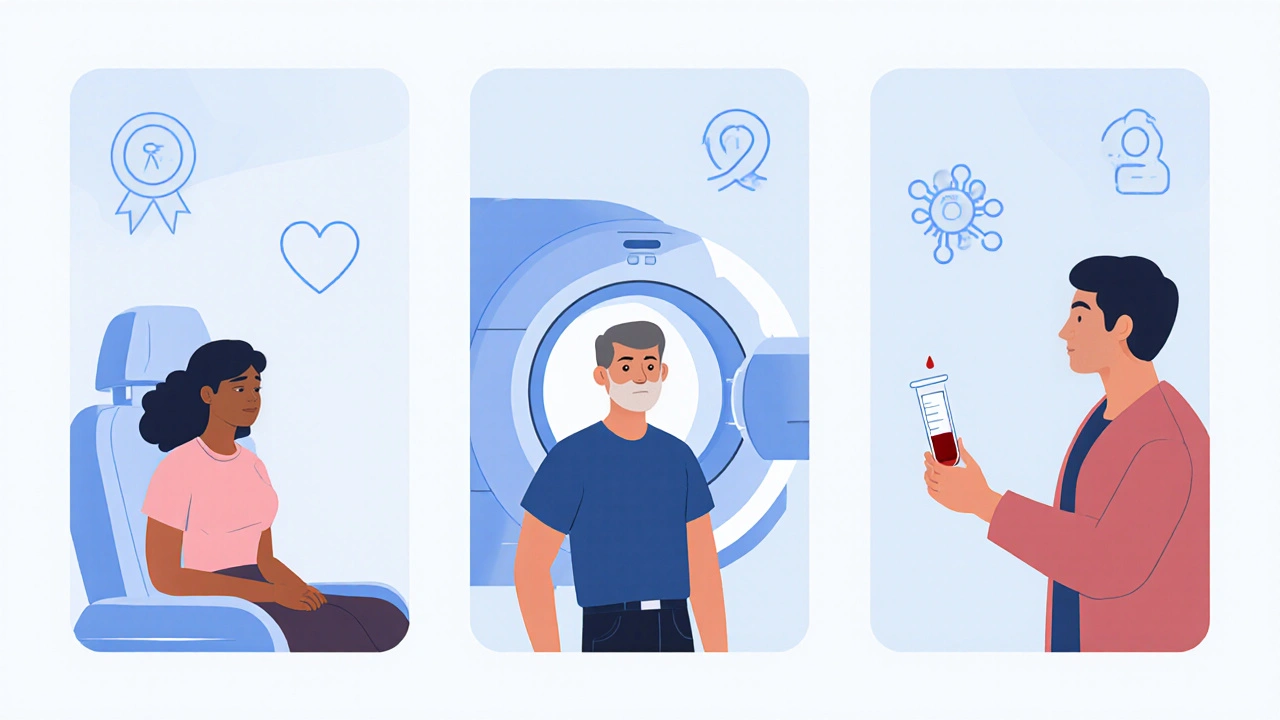Health Screening Risk Assessment Tool
Personal Health Risk Profile
Answer the following questions to calculate your personalized screening recommendations.
Your Personalized Screening Plan
Imagine finding a problem before it becomes a crisis - that’s the power of early detection. Spotting health issues at their inception can shrink treatment costs, boost survival odds, and keep daily life running smoothly. This article breaks down why acting early matters, which conditions benefit most, and how you can weave proactive screening into your routine.
Key Takeaways
- Early detection identifies diseases at treatable stages, raising survival rates by up to 90% for many cancers.
- Preventive screenings cut long‑term healthcare expenses by 30‑40% on average.
- Regular risk assessments empower patients to make informed lifestyle changes.
- Balancing benefits and harms prevents over‑screening and false‑positive stress.
- A simple checklist can keep your yearly health checks on track.
What is Early Detection?
Early detection is the systematic process of identifying a disease or health condition before symptoms appear, typically through screening tests, biomarkers, or risk‑based assessments. By catching issues when they’re small, treatment can be less invasive and more effective.
How Early Detection Works Across Major Diseases
Different illnesses have their own screening tools, but the underlying principle stays the same: look for tell‑tale signs before the body signals distress.
Cancer
For breast, colorectal, and cervical cancers, routine mammograms, colonoscopies, and Pap smears have slashed mortality. A 2023 analysis showed that women diagnosed with stageI breast cancer have a 99% five‑year survival rate, versus 27% for stageIV.
Cardiovascular Disease
Blood pressure checks, lipid panels, and coronary calcium scans catch artery narrowing early. People who begin statin therapy after a modest LDL‑C elevation reduce heart‑attack risk by 25% over a decade.
Diabetes
Fasting glucose and HbA1c tests flag pre‑diabetes. Lifestyle interventions launched at this stage lower the progression to full‑blown type2 diabetes by up to 58% (Diabetes Prevention Program, 2022).

Benefits of Catching Problems Early
Three major advantages drive the push for systematic screening.
Higher Survival and Recovery Rates
When cancers are found at stageI or II, surgical removal often suffices, avoiding chemotherapy’s harsh side effects. Early‑stage lung cancer detected via low‑dose CT scans yields a 20% five‑year survival versus 5% for later stages.
Cost Savings for Patients and Health Systems
Treatment for advanced disease can be three‑to‑four times more expensive. A 2024 health‑economics study calculated that nationwide early‑detection programs for colorectal cancer saved $4.2billion in treatment costs over five years.
Preserved Quality of Life
Less aggressive therapies mean fewer hospital stays, reduced side‑effects, and faster return to work. Surveys of early‑detected heart‑failure patients show 80% report “normal” daily activity levels, compared with 45% in late‑stage cohorts.
Implementing Early Detection in Your Life
Putting the concept into practice doesn’t require a medical degree - just a clear plan.
Know Your Personal Risk Factors
Age, family history, smoking status, and BMI shape which screenings are most relevant. Tools like the CDC's Risk Assessment Calculator let you input these variables and receive a customized schedule.
Follow Evidence‑Based Screening Guidelines
Organizations such as the American Cancer Society, USPSTF, and WHO publish age‑specific recommendations. For example:
- Women 40‑74: Mammogram every 2years.
- Adults 45‑75: Colonoscopy every 10years or FIT annually.
- All adults 20‑79: Blood pressure check at least once every 2years.
Choose Reliable Tests and Providers
Look for accredited labs (CLIA‑certified in the U.S.) and clinicians who follow standardized protocols. Peer‑reviewed data confirm that low‑dose CT for lung cancer is most accurate when performed at certified centers.
Common Pitfalls and How to Avoid Them
Even well‑intentioned screening can backfire if not handled wisely.
False Positives and Unnecessary Anxiety
Some tests, like PSA for prostate cancer, generate many false alarms. When a result is borderline, seek a confirmatory test before jumping to invasive procedures.
Over‑Screening
Screening too frequently can raise radiation exposure and medical costs without added benefit. Stick to guideline intervals unless a doctor advises otherwise based on elevated risk.
Missing Follow‑Up
Abnormal findings lose their advantage if you ignore the next step. Set reminders, ask for a clear action plan, and keep a log of all results.

Quick Reference: Early vs. Late Detection Comparison
| Condition | Stage Detected | 5‑Year Survival | Average Treatment Cost | Quality‑of‑Life Rating* (1‑10) |
|---|---|---|---|---|
| Breast Cancer | Early (StageI) | 99% | $45,000 | 9 |
| Breast Cancer | Late (StageIV) | 27% | $180,000 | 4 |
| Colorectal Cancer | Early (StageII) | 85% | $70,000 | 8 |
| Colorectal Cancer | Late (StageIV) | 14% | $210,000 | 3 |
| Heart Disease | Early (asymptomatic) | 95% | $30,000 | 9 |
| Heart Disease | Late (post‑MI) | 70% | $120,000 | 6 |
*Based on patient‑reported outcomes in peer‑reviewed studies (2022‑2024).
Personal Screening Checklist
- Mark your birth year - determines age‑based tests.
- List family history of cancer, heart disease, and diabetes.
- Complete an online risk calculator (CDC, WHO, or local health agency).
- Schedule the recommended screenings for the year.
- Write down each appointment date and required preparation (fasting, contrast dye, etc.).
- After each test, note the result and next steps; set a reminder for follow‑up if needed.
- Review your checklist annually and update risk factors.
Conclusion: Make Early Detection a Habit
Waiting for symptoms is like ignoring a leaky roof until the ceiling collapses. By integrating evidence‑based screenings, you gain a safety net that catches health problems while they’re still manageable. The payoff? Longer, healthier years and lighter medical bills. Start today - assess your risk, book that overdue mammogram or blood‑pressure check, and keep the checklist handy.
Frequently Asked Questions
How often should I get a full physical exam?
For adults without chronic conditions, a comprehensive exam every 2‑3years is sufficient. Those with risk factors (family history, smoking) should see a physician annually.
Can early detection cause more harm than good?
When screenings follow guideline‑based intervals and use validated tests, benefits outweigh risks. Over‑screening can lead to false positives and unnecessary procedures, so stick to recommended schedules.
What are the most cost‑effective screenings?
Blood pressure checks, cholesterol panels, and FIT (fecal immunochemical test) for colorectal cancer are low‑cost yet high‑impact. They can be done in primary‑care settings for under $50 per test.
Should I get screened for cancer if I have no symptoms?
Yes. Many cancers are asymptomatic in early stages. Following age‑ and risk‑based guidelines (e.g., mammograms at 40+, colonoscopy at 45) dramatically improves outcomes.
How can I track my screening history?
Use a personal health record app or a simple spreadsheet: record test type, date, result, and next‑due date. Many electronic medical portals also provide a downloadable summary.


maurice screti
October 7, 2025 AT 17:00When one contemplates the vast tapestry of modern medicine, the notion of early detection emerges as an elegant thread that binds prevention to longevity. It is not merely a clinical recommendation, but a philosophical stance that privileges foresight over reactive treatment. In the realm of oncology, the differential between a stage I carcinoma and its stage IV counterpart often hinges on the punctuality of a mammogram or colonoscopy. Such diagnostics, while seemingly trivial, orchestrate a cascade of therapeutic options that are less invasive, more cost‑effective, and statistically more successful. Consider the epidemiological data: a ninety‑nine percent five‑year survival rate for early breast cancer versus a stark twenty‑seven percent for metastasized disease. These figures are not abstract numbers; they reflect real lives prolonged, families spared, and economies shielded from exorbitant treatment expenditures. Moreover, cardiovascular screening through routine lipid panels and blood pressure checks can preempt myocardial infarctions that would otherwise devastate productive years of employment. The incremental cost of a lipid profile pales in comparison to the multi‑million‑dollar burden of an acute coronary event. In diabetes management, the identification of pre‑diabetes via HbA1c grants an opportunity for lifestyle intervention that can abort the progression to full‑blown disease. Lifestyle modifications, though demanding discipline, are dramatically more humane than insulin regimens that follow inevitable disease onset. From a systems perspective, health insurers observe a thirty to forty percent reduction in long‑term spending when preventive screenings are adhered to. This reduction is not a mere accounting trick; it translates to lower premiums for the insured and a more sustainable allocation of limited resources. The psychological benefit of knowing one is taking proactive steps cannot be overstated; it engenders a sense of agency and reduces the anxiety associated with the unknown. Nevertheless, the balance must be struck; over‑screening can engender false positives that lead to unnecessary interventions and iatrogenic harm. Guidelines such as those promulgated by USPSTF exist precisely to navigate this delicate equilibrium. Thus, cultivating a disciplined yet discerning screening regimen is an intellectual exercise in risk management that ultimately honors the sanctity of human life.
Abigail Adams
October 13, 2025 AT 17:00Empirical evidence unequivocally supports that systematic screening protocols considerably diminish morbidity across numerous pathologies. For instance, the prevalence of colorectal carcinoma detected at an early stage has risen markedly following the adoption of FIT testing in primary care. Moreover, the cost‑effectiveness analyses published in the Journal of Preventive Medicine demonstrate a favorable incremental cost‑utility ratio for biennial mammography in women aged 50 to 74. It is imperative that individuals calibrate their screening schedule to align with evidence‑based guidelines rather than anecdotal recommendations. Adherence to USPSTF directives not only optimizes health outcomes but also mitigates the risk of iatrogenic sequelae associated with overdiagnosis. Consequently, the prudent course of action involves periodic recalibration of personal risk factors in consultation with a qualified healthcare professional.
Belle Koschier
October 19, 2025 AT 17:00Taking a balanced perspective, it’s useful to view early detection as a partnership between patient and provider. By openly discussing family history, lifestyle habits, and any concerns, the screening plan can be tailored to individual needs. This collaborative approach respects personal autonomy while ensuring that high‑impact tests aren’t missed. It also helps people feel more invested in their own health journey, which often leads to better adherence to follow‑up recommendations.
Allison Song
October 25, 2025 AT 17:00One might reflect that the act of screening is, at its core, an exercise in humility-recognizing that the body can harbor unseen threats. Yet, it also embodies agency, allowing us to intervene before chance dictates outcomes. In this light, regular check‑ups become a quiet affirmation of responsibility toward oneself and one’s community.
Joseph Bowman
October 31, 2025 AT 17:00Even though many health agencies push for routine tests, it's worth wondering who's really benefitting from the data they collect. Some argue that pharma and insurance companies gain insights that shape market strategies, potentially steering us toward more expensive interventions. Staying informed and questioning the motives behind widespread screening campaigns can ensure we aren't unwittingly part of a larger agenda.
Singh Bhinder
November 6, 2025 AT 17:00From an inquisitive standpoint, I’ve been curious about how socioeconomic status influences access to these recommended screenings. Data suggests that under‑insured populations often delay or forego preventive tests, which in turn amplifies health disparities. Addressing these gaps would require policy adjustments that make screenings universally affordable and accessible.
Kelly Diglio
November 12, 2025 AT 17:00Indeed, equity in healthcare is paramount. Initiatives such as community‑based mobile clinics have shown promise in delivering mammograms and blood pressure checks to underserved neighborhoods. By partnering with local organizations, these programs can bridge the gap and ensure that early detection isn’t a privilege reserved for a few.
Carmelita Smith
November 18, 2025 AT 17:00Screening saves lives! :)
Liam Davis
November 24, 2025 AT 17:00It’s fascinating how a simple blood pressure check-costing less than a coffee-can prevent a heart attack. Moreover, routine cholesterol tests have a well‑documented impact on reducing stroke risk. Consistency is key; scheduling these appointments annually can make a profound difference.
Arlene January
November 30, 2025 AT 17:00Totally agree-those quick labs are worth it! 🎉
Kaitlyn Duran
December 6, 2025 AT 17:00Quick tip: set a calendar reminder for your yearly check‑up.